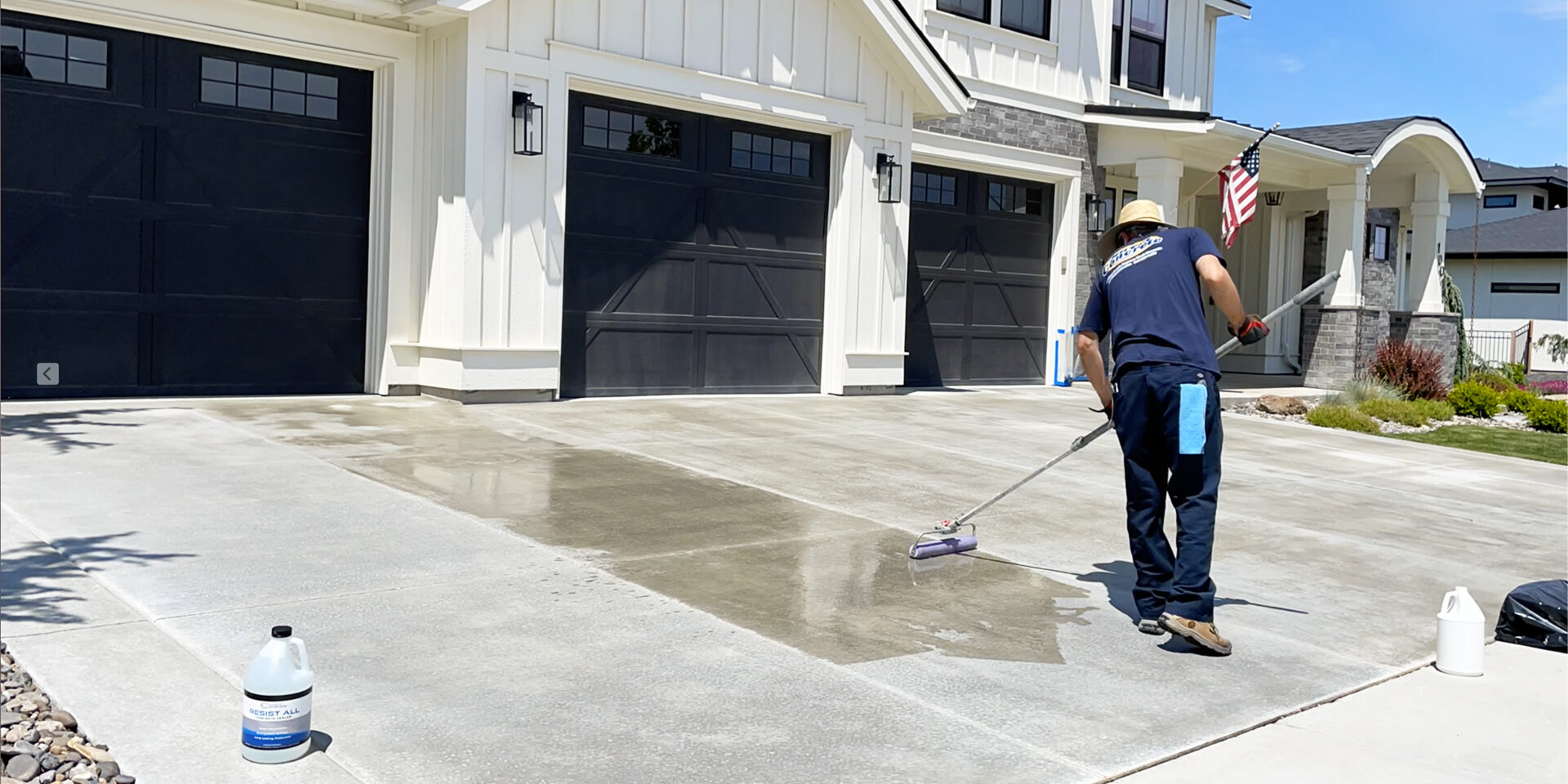How To Seal A Concrete Driveway
So the driveway of your your house is like a business man’s tie, if it’s ugly you bet people will judge you… so the next question is how to seal a concrete driveway so it doesn’t look like a tie with mustard stains on it? This is where people drive up to visit you. Most likely they have to walk across it to enter your home. So why do so many people neglect their driveways?
The answer is simple… people don’t know how to maintain their concrete like they would their house paint. Painting your house is a simple concept in anyone’s mind. Just like you can enjoy a well landscaped front yard, not a lot of people know how to plant things so that they look good. Same goes with concrete maintenance.
But maintaining your concrete driveway is easier than you think! Let’s go over how to clean up your driveway first before we get into protecting it.
Clean It Up
The biggest problems I see are mold growth, oil stains, and spalling. First, the best way to clean concrete is with a pressure washer. I like to use a turbo wand which spins around the stream of water super fast. This prevents the stream from blowing the concrete apart. The fan tips tend to leave a zebra pattern on the concrete if it’s not done right. So grab that turbo tip and use that thing. It will help you do a more thorough cleaning on the concrete.
Start up by the house and work your way away from the home. Even if it’s pitched towards the home, you can blast the dirty water to the sides. Take your time with this. If you leave a bunch of mold and dirt on the concrete that could inhibit the sealing process later. Lower psi pressure washers can take a little more time to clean everything but it can all be done in one day for sure.
Mold Stains
Stubborn mold stains can be removed with a mold cleaner like Mold And Mildew Cleaner from SealGreen. This will dissolve the mold stains without harsh chemicals like bleach. Although bleach does work to kill mold, it can leave the concrrete looking blotchy and can kill grass and other plants after it’s washed off.
Oil Stains
Removing oil stains can be a little more tricky. Usually I’ll use an oil eating enzyme cleaner like Oil Cleaner Degreaser Concentrate from SealGreen. Ge the concrete wet then pour a little cleaner onto the oil spots. Scrub it well with a deck brush or firm bristle broom for as long as possible. The longer it’s agitated the better it works. Then pressure wash it and see how it looks. You can repeat this process if needed.
A lot of times the oils have soaked deep into the substrate and the cleaners are only removing the oils from the top. This can leave “ghost” stains on the concrete. If this is the case I like to use a poultice based powder to leech the oils out of the concrete after the concrete is dry. Gray Out works great for this. I just put some of the powder over the stain and tape some plastic, like a square cut out of a trash bag, over it so the powder doesn’t blow away. I’ll sweep it up a couple days later and reapply if needed. This usually lightens up or completely removes the oils that have soaked into the concrete.
Spalling And Ice Melt Damage
I won’t go over this in great detail because I’ve already written extensively about this here. Check out that blog and watch the accompanying videos on the process. Briefly, you blow out any damaged areas with the pressure washer. The next day after the concrete is dry, you can patch the areas with a cement based concrete patch.
Here’s How To Seal A Concrete Driveway
Now your concrete should be ready for protection… so this is how to seal a concrete driveway! But first, which sealer is right for you? The most common mistake I see is when people get a surface sealer (topical sealer) and apply that to their driveways. This makes the surface slippery when it rains and usually peels up quickly. Now I use surface sealers after staining driveways a couple times a year but I would recommend hiring a professional in your area to do that type of service.
The correct sealer for most applications is called a penetrating sealer (or impregnating sealer). This is the type of sealer that soaks into the substrate but doesn’t change the look or sheen of the concrete. There’s a couple different types of these sealers so let’s go over them.
Extreme Penetrating Sealer
A deep penetrating sealer migrates further into the slab compared to other types of penetrating sealers. The one I use for my clients is Extreme Penetrating Sealer. I like this sealer because it’s a one time application. It permanently waterproofs the concrete which is great in northern climates. See, spalling is caused by freeze / thaw expansion and contraction. This creates a huge amount of tension on the concrete which leads to spalling and chipping. This is completely eliminated after the concrete is treated with Creto DPS. The slab won’t allow water into it so the concrete won’t expand and contract under freezing temperatures.
The downside of this sealer is that it’s not as chemical resistant. Spills have a much greater chance of leaving a surface stain on the concrete. It’s not hydrophobic either. So the look some people wat when the water beads up on top of the concrete, this sealer doesn’t do that.
When you apply a sealer like Creto DPS you want to keep the area wet with sealer for at least 20-30 minutes. This allows the sealer time to soak deep into the substrate which will give it maximum protection. I like to spray the sealer on with a pump sprayer but a paint roller and extension works as well.
Stain Resistant Sealer
These are the more typical penetrating sealers. They are hydrophobic, so water beads up on top of the concrete after they’re applied. They are also more resistant to stains. I would recommend this type of sealer (like Resist All) if you are worried about oil or other stains on your concrete.
These sealers make cleaning your driveway much easier… just hose off the surface and you’re good. The downside is that they are not permanent. So every couple of years you have to pressure wash and reapply the sealer.
Now technically they are still sealed and will resist stains much more than raw concrete. But the water repellency starts to wane over time. So if you want that cool look of the water beading up on top then you have to reseal every so often.
These sealers can be applied by pouring the sealer directly onto the concrete and rolling it on… kind of like you would paint. Or you can use a pump sprayer and spray it on as well.
Conclusion
So I hope this answers all of your questions you might have about how to seal a concrete driveway. If you have any questions that this article didn’t answer, please feel free to fill ou the contact form on the home page. I can help you out with whatever information you might need. Also if you’re in the Treasure Valley area I can provide this service for you so you don’t even have to any of this!
Check out this quick video on the process and good luck on your project!








